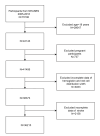Hemoglobin-to-red blood cell distribution width ratio is negatively associated with stroke: a cross-sectional study from NHANES
- PMID: 39543321
- PMCID: PMC11564829
- DOI: 10.1038/s41598-024-79520-x
Hemoglobin-to-red blood cell distribution width ratio is negatively associated with stroke: a cross-sectional study from NHANES
Abstract
Numerous studies have suggested that the hemoglobin-to-red blood cell distribution width ratio (HRR) is associated with the onset, progression, and prognosis of various diseases. However, to the best of our knowledge, no research has conducted statistical analyses to determine the association between HRR and stroke. This cross-sectional study was conducted among adults with complete data on hemoglobin-red cell distribution width ratio (HRR) and stroke from the 2005-2018 National Health and Nutrition Examination Survey (NHANES). HRR was calculated by dividing hemoglobin (HGB) in grams per deciliter (g/dL) by the red blood cell distribution width (RDW). Weighted multivariable logistic regression and generalized additive models were employed to investigate the independent and nonlinear relationships between HRR and stroke. Threshold effects were assessed using two-piece linear regression models. Additionally, subgroup analyses and interaction tests were performed. A total of 36,215 participants were included, with 2.92% classified as stroke patients. The prevalence of stroke decreased across increasing tertiles of HRR (Q1: 5.07%; Q2: 2.63%; Q3: 1.69%; P < 0.0001). A negative association between HRR and stroke was observed in both unadjusted and adjusted models. In Model III, each one-unit increase in HRR was associated with a 58% reduction in the likelihood of stroke (Model III: OR = 0.42, 95% CI: 0.29-0.63). Subgroup analyses and interaction tests revealed that the association between HRR and stroke was BMI-dependent (P < 0.05), with the negative association only observed in participants with BMI < = 25 and BMI 25-30, but not in those with BMI > 30. Using a two-piece linear regression model, a threshold effect was identified at a BMI of 30 (K = 1.16). To the left of this breakpoint, there was a negative association between HRR and stroke (OR = 0.55, 95% CI: 0.27-0.97), whereas no such association was detected to the right of the breakpoint (OR = 6.49, 95% CI: 0.75-56.11). HRR is negatively associated with the likelihood of stroke, with a lower risk of stroke in individuals with higher HRR levels.
Keywords: Cross-sectional study; Hemoglobin-to-red cell distribution width ratio; NHANES; Population-based study; Stroke.
© 2024. The Author(s).
Conflict of interest statement
Figures



Similar articles
-
Predictive role of red blood cell distribution width and hemoglobin-to-red blood cell distribution width ratio for mortality in patients with COPD: evidence from NHANES 1999-2018.BMC Pulm Med. 2024 Aug 26;24(1):413. doi: 10.1186/s12890-024-03229-w. BMC Pulm Med. 2024. PMID: 39187816 Free PMC article.
-
Association of hemoglobin-to-red blood cell distribution width ratio and bone mineral density in older adults.BMC Musculoskelet Disord. 2024 Oct 30;25(1):866. doi: 10.1186/s12891-024-07984-z. BMC Musculoskelet Disord. 2024. PMID: 39472899 Free PMC article.
-
Association between hemoglobin-to-red blood cell distribution width ratio and chronic kidney disease: A cross sectional study.Medicine (Baltimore). 2024 Nov 8;103(45):e40224. doi: 10.1097/MD.0000000000040224. Medicine (Baltimore). 2024. PMID: 39533601 Free PMC article.
-
Trends in hemoglobin-to- red cell distribution width ratio and its prognostic value for all-cause, cancer, and cardiovascular mortality: a nationwide cohort study.Sci Rep. 2025 Mar 5;15(1):7685. doi: 10.1038/s41598-025-92228-w. Sci Rep. 2025. PMID: 40044826 Free PMC article.
-
Association between reduced hemoglobin-to-red cell distribution width ratio and elevated cardiovascular mortality in patients with diabetes: Insights from the National Health and Nutrition Examination Study, 1999-2018.Clin Hemorheol Microcirc. 2025;89(1):69-81. doi: 10.3233/CH-242209. Clin Hemorheol Microcirc. 2025. PMID: 39439352
Cited by
-
Associations of Naples prognostic score with stroke in adults and all cause mortality among stroke patients.Sci Rep. 2025 Mar 28;15(1):10718. doi: 10.1038/s41598-025-94975-2. Sci Rep. 2025. PMID: 40155756 Free PMC article.
-
Relationship between the hemoglobin-to-red cell distribution width ratio and post-stroke cognitive impairment: a prospective study.Front Aging Neurosci. 2025 Apr 30;17:1552956. doi: 10.3389/fnagi.2025.1552956. eCollection 2025. Front Aging Neurosci. 2025. PMID: 40370755 Free PMC article.
-
Association between hemoglobin-to-red blood cell distribution width ratio and rheumatoid arthritis in US adults: evidence from the national health and nutrition examination survey 2009-2018.Prev Med Rep. 2025 Jul 9;56:103169. doi: 10.1016/j.pmedr.2025.103169. eCollection 2025 Aug. Prev Med Rep. 2025. PMID: 40687061 Free PMC article.
-
Efficacy of Hypoxia-Inducible Factor Prolyl-Hydroxylase Inhibitors in Renal Anemia: Enhancing Erythropoiesis and Long-Term Outcomes in Patients with Chronic Kidney Disease.Biomedicines. 2024 Dec 23;12(12):2926. doi: 10.3390/biomedicines12122926. Biomedicines. 2024. PMID: 39767832 Free PMC article.
References
-
- Feigin, V. L. et al. World Stroke Organization (WSO): global stroke fact sheet 2022. Int. J. Stroke Off. J. Int. Stroke Soc.17(1), 18–29 (2022). - PubMed
-
- Orellana-Urzúa, S., Rojas, I., Líbano, L. & Rodrigo, R. Pathophysiology of ischemic stroke: Role of oxidative stress. Curr. Pharm. Des.26(34), 4246–4260 (2020). - PubMed
MeSH terms
Substances
LinkOut - more resources
Full Text Sources
Medical

